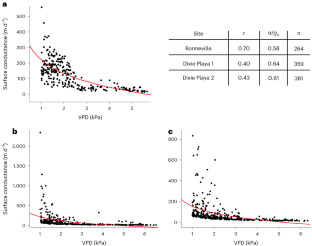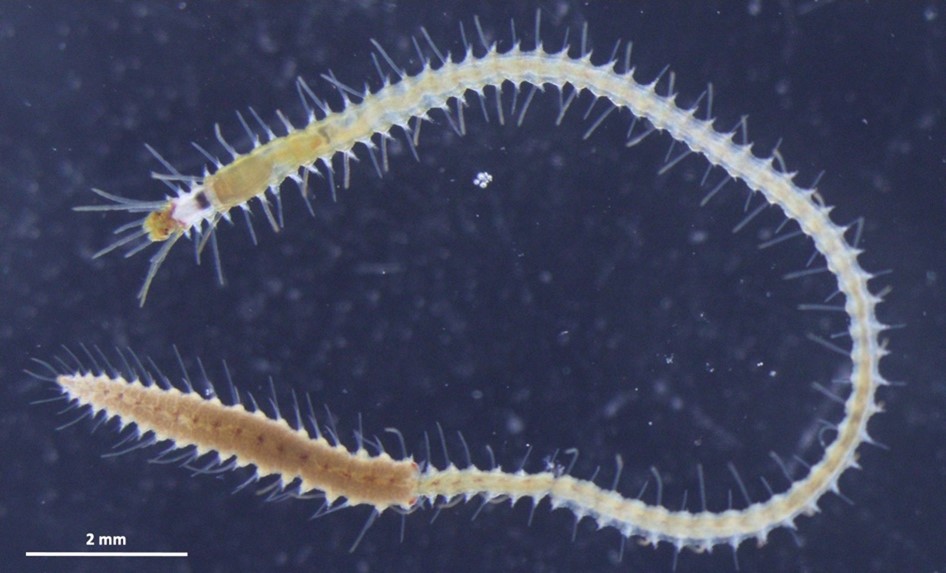2023-11-20 ハーバード大学
◆ハーバード大学の研究チームは、植物の乾燥対策である気孔を閉じるメカニズムが、乾燥した空気よりもむしろ乾燥した土壌によって引き起こされる可能性があることを示唆。これは、世界の植物生態系において土壌の湿度が気温上昇と同様に重要であることを示し、将来の水の予測に焦点を当てるべきであることを示唆している。
<関連情報>
- https://seas.harvard.edu/news/2023/11/plant-free-place-clues-about-how-help-plants-survive-planet-warms
- https://www.nature.com/articles/s44221-023-00147-9
- https://agupubs.onlinelibrary.wiley.com/doi/10.1029/2020JG005665
植物がない場合の蒸気圧不足に対する見かけの表面コンダクタンスの感度 Apparent surface conductance sensitivity to vapour pressure deficit in the absence of plants
Lucas R. Vargas Zeppetello,Kaighin A. McColl,Jeremiah A. Bernau,Brenda B. Bowen,Lois I. Tang,N. Michele Holbrook,Pierre Gentine & Peter Huybers
Nature Water Published:16 October 2023
DOI:https://doi.org/10.1038/s44221-023-00147-9

Abstract
A growing literature argues that ecosystem-scale evapotranspiration is more sensitive to drying of the atmosphere because of stomatal regulation by plants than to reductions in surface soil moisture. Past studies analysed observations, for which it is difficult to conclusively control for potential relations among plant physiology, measurable state variables such as vapour pressure deficit (VPD) or soil moisture, and ecosystem-scale water flux. Here we analyse natural mechanism-denial experiments at non-vegetated but hydrologically active salt flats. At these sites, any apparent sensitivity of the ecosystem-scale surface conductance (gs, a bulk measure of how the land surface influences evapotranspiration) to VPD cannot be due to stomatal closure. Over the salt flats we find a VPD–gs relation similar to that commonly attributed to stomatal closure, and reproduce similar relations using a parsimonious boundary layer model that excludes plants. We conclude that observational studies probably overstate the sensitivity of ecosystem-scale surface conductance to atmospheric drying and understate the importance of variations in surface soil moisture. This finding has broad implications for future ecosystems, because anthropogenic trends in soil moisture are uncertain and spatially heterogeneous whereas ubiquitous atmospheric drying is expected due to global warming.
高い蒸気圧不足は半乾燥生態系における雨によるパルスの生産性と水利用効率を低下させる High Vapor Pressure Deficit Decreases the Productivity and Water Use Efficiency of Rain-Induced Pulses in Semiarid Ecosystems
Matthew C. Roby, Russell L. Scott, David J. P. Moore
Journal of Geophysical Research: Biogeosciences Published: 24 August 2020
DOI:https://doi.org/10.1029/2020JG005665

Abstract
Intermittent rain events drive dynamic pulses of carbon and water exchange in many arid and semiarid ecosystems. Although soil moisture is known to control these pulses, the effect of atmospheric dryness on pulses is not well documented. Here we hypothesized that vapor pressure deficit (VPD) modulates net ecosystem production (NEP) and ecosystem-scale water use efficiency (WUE) during pulse events due to its effects on canopy stomatal conductance and evapotranspiration. We quantified relationships between VPD and carbon and water exchange during growing season rain events and tested their generality across four semiarid flux sites with varied vegetation in the southwest United States. Across grassland, shrubland, and savanna sites, we found that high VPD during pulses suppressed ecosystem photosynthesis and surface conductance to a greater degree than respiration or evapotranspiration, particularly when soil moisture was high. Thus, periods of high VPD were associated with a 13–64% reduction in NEP and an 11–25% decrease in WUE, relative to moderate VPD conditions. Sites dominated by shrubs with the C3 photosynthetic pathway were more sensitive to VPD than sites dominated by C4 grasses. We found that a 1 kPa increase in VPD reduced the average NEP of pulse events by 13–56%, which illustrates the potential for projected increases in atmospheric demand to reduce the net productivity of semiarid ecosystems.
Plain Language Summary
In many water-limited regions, summer storms provide water that drives brief periods of high ecosystem activity (photosynthesis, respiration, and evapotranspiration) called “pulse events”. While many studies have focused on soil moisture as a control on pulse events, it is not well known how changes in the air’s evaporative strength, or dryness, influence patterns of carbon and water exchange during pulses. We analyzed data from four semiarid sites in southern Arizona and found that air dryness modified the widely accepted pulse framework of carbon and water exchange for semiarid areas. Drier air led to larger reductions in photosynthesis than respiration and evapotranspiration, which decreased the overall productivity and water use efficiency of plants. These findings indicate the potential for drier air in a warming climate to reduce the ability of dryland plants to use water. Because pulses are important for the carbon balance of these systems, drier during these critical pulse periods could reduce how much carbon global drylands remove from the atmosphere. Incorporating the effects of air dryness on pulse patterns into models may help us better understand global change impacts on semiarid ecosystems.
Key Points
- We extend the pulse framework of carbon and water exchange in semiarid ecosystems to include atmospheric demand for moisture
- High atmospheric demand drove larger reductions in photosynthesis than respiration, which decreased the net productivity and water use efficiency of rain pulses
- Ecosystem photosynthesis was most sensitive to high atmospheric demand in sites dominated by C3 shrubs when soil moisture was high


